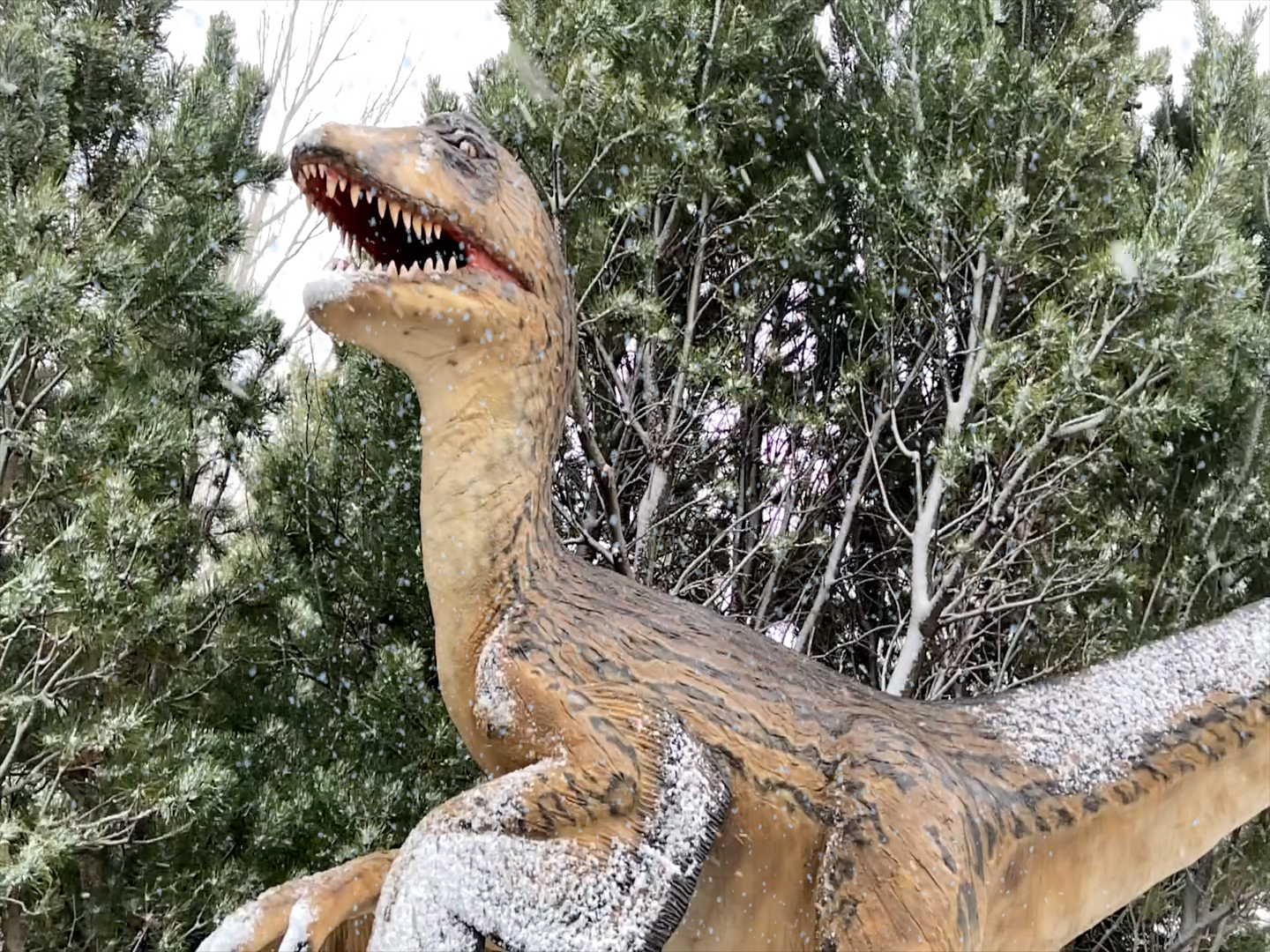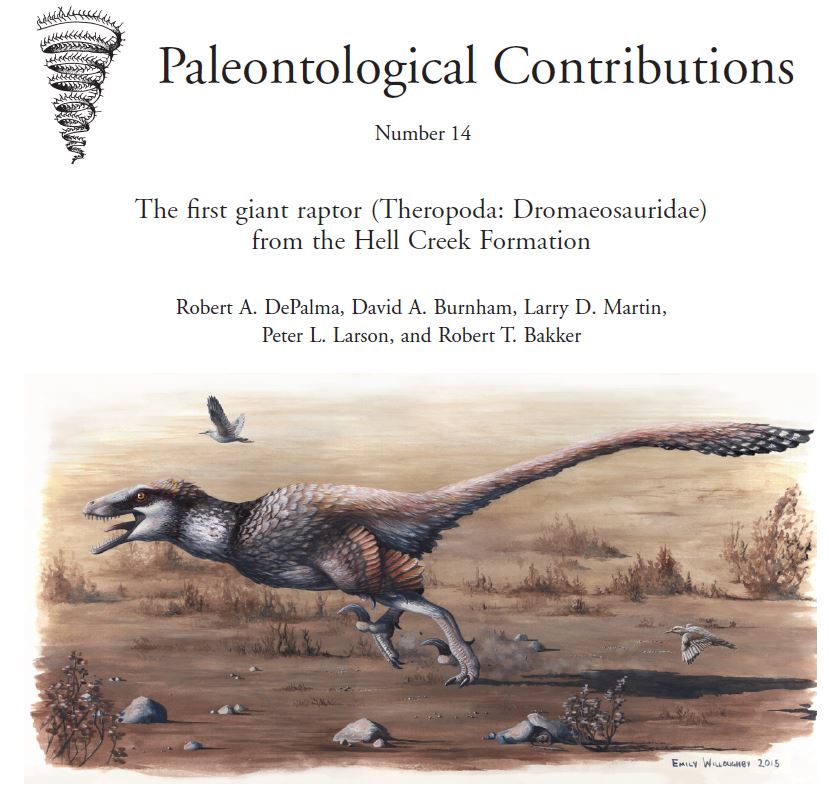
Species: steini
Range: Late Cretaceous (Maastrichtian, 70-65 MYA) of South Dakota
Size estimate: 17-20 ft length, 750-850 lbs
Discovery: Robert DePalma, 2015
Classification: dinosauria, saurischia, theropoda, maniraptora, dromeosauridae
Since no one has ever seen a living dinosaur, and the missing pieces of the fossil record withhold important clues to their appearance, no artistic representation of a dinosaur ever gets it 100% right. On top of that, new discoveries can change our ideas of extinct creatures drastically. So, how close does this sculpture come to what we know of the original animal?
• Behind the Scenes: To clarify this sculpture’s relationship to the dinosaur it represents, it helps to know that the sculpture predates the discovery of Dakotaraptor by several years and was altered to represent Dakotaraptor a few years after the taxon’s publication. We included it as part of a larger project of updating the Park’s sculptures to reflect discoveries of feathers in dinosaurs. As the only giant raptor which preserved direct evidence of feathers in 2015 (and remains so as of 2024), we considered Dakotaraptor a particularly important part of that project. It also happened that the Park held four large ‘raptor sculptures, and by 2018 scientists had named four giant raptor genera. Serendipity! We chose this sculpture to represent Dakotaraptor because the original description of the species suggested something shaped like Deinonychus, but much larger. Considering that this sculpture set out to represent a different dinosaur (probably Utahraptor), it deals with layers of problems in accuracy.
• AND YET, one saving grace for the sculpture comes from the incompleteness of our knowledge about this species. DePalma and colleagues based the taxon description on two associated but incomplete skeletons and assigned a few fossils found in the area to it. What we know of this species consists of much of its hands, arms, legs, part of its back, and bits of its tail. Loose teeth have also been assigned to Dakotaraptor. It lacks much of the skull, torso, and hips. Features of the recovered bits do justify calling it a distinct species, but they don’t make much difference in terms of its general appearance. In other words, at the moment, a big generic ‘raptor does a reasonable job of portraying it because the parts that might make it look distinct remain unknown. Therefore, given the broad parameters presented by the fossils, we can consider the head, neck, torso, and hips neither accurate nor inaccurate, but speculative placeholders appropriate for completing the character, nothing more.
• At least the teeth aren’t generic cones!
• As mentioned earlier, Dakotaraptor currently ranks as the largest dromaeosaur to preserve direct evidence of its skin, namely, feathers on its arms. Like Velociraptor before it and Dineobellator after it, this evidence comes in the form of quill knobs. Some feathers and scales, especially flight feathers or facial scales, grow so close to the surface of the bone that they can influence its growth or remodeling. Flight feathers of large birds like condors or eagles may even attach directly to the bone via a ligament in order to support the animal’s weight while in flight. When stressed, these feathers tug on the bone via that ligament, causing it to remodel into a bump to strengthen the attachment. Quill knobs therefore happen as an individual thing resulting from lifestyle, not as a species-wide characteristic. When they occur, they signal that whatever the animal did with its feathers, it involved vigorous movement that might tug on the feathers. Finding quill knobs on Dakotaraptor not only demonstrates it grew a coat of feathers, they also show that it used those feathers for some arm-swinging action. No, this does not support flight, but it could deal with any number of other vigorous behaviors ranging from climbing trees, display behaviors, using the arms to enhance extreme running maneuvers, or the like. We don’t know how long those feathers got or details of their shape, though we can reasonably suppose from the pattern of feathering among its relatives that Dakotaraptor bore familiar birdlike remiges (flight feathers) on at least its arms despite growing far too large for flight.
• Details of its other plumage features depicted on this sculpture remain wholly speculative. We don’t know if it bore a tail fan or not. Some contend that all dromaeosaurs must have grown a tail fan based on impressions found with Tianyuraptor from China and suggestions of a fused pygostyle at the tip of some specimens’ tails, which developed in birds to support a fanlike tail. However, impressions of the tiny, immature Wulong ‘raptor and the first bird, Archaeopteryx, show that tail plumage could indeed vary from such a pattern; likewise, not all birds bear tail fans despite its presence in their common ancestor, especially birds that gave up the capacity for flight. We chose to add a tail fan in this case to illustrate its plausibility, but its shape does not resemble the fans found in Tianyuraptor, Microraptor, or any other relative.
We have no data for Dakotaraptor’s body feathers, but this sculpture goes with birdlike contour feathers for practical reasons—a fluffier or shaggier plumage presents its share of durability issues. The sculpture originally bore a scalier surface, and if you look closely, you may see remnants of that scaliness showing through, especially on the legs. Current knowledge strongly suggests the original animal would not bear scales interspersed among its feathers like this.
Speaking of the legs, impressions from other dinosaurs with true feathers preserve a pattern that suggests once this branch of the dinosaur family tree developed them, they largely lost the ability to grow scales. Their relatives the birds learned a complicated developmental trick that allows them to grow scales on their legs before switching on the hormones that start feather growth, but other dinosaur groups do not appear to have independently acquired this ability. Developmental quirks and congenital diseases confirm that feathers are developmentally demanding, so when dinosaurs acquired them, they had to go all in and give up scales altogether, at least so far as the data currently show. This may also mean that in dinosaurs which preserve both scale impressions and fuzz of some sort, even branching fuzz, that fuzz probably plays by different developmental rules than true feathers. Ironically, though scaly dinosaurs might bear birdlike scalation on their toes, feathered dinosaurs most likely did not.
As for other plumage, we simply have no data, and therefore chose to avoid giving it a flamboyant head crest like a cockatoo or the feathery bellbottoms of some breeds of chicken. Other artists sometimes graft features inspired by modern animals to satisfy aesthetic whims or give the animal a personal stamp, but we feel that attributing exceptional body structures to our renditions without supporting data misrepresents both the art and the science, resulting in an improbable, distorted portrayal.
• Since the original sculpture used non-scientific models as a basis for the pose of its arms, possibly because published results had not yet become available, they presented major challenges for getting the look of the feathers on those arms correct. What you see is the best negotiation we could manage. Fortunately, the resultant positioning ended up hiding some of the worst flaws, and our Dakotaraptor turned out better than the nearby Achillobator, with its awkward feather configuration laid bare by its outstretched arms. Even so, these Dakotaraptor forelimbs don’t closely match what we know of its range of motion. The publication cover for Dakotaraptor’s species description includes an illustration which shows a much better stance for a running ‘raptor: like ninja in various anime, ‘raptors probably ran with their arms flung backward so as to keep their feathery arms out of the way in an acceptably aerodynamic manner. They could not fold their arms like birds generally fold their wings, suggesting that using them for grasping like their more basal theropod cousins imposed some kind of constraint on their joints. Birds specialized their wings so much that they lost that grasping function almost entirely, with few exceptions like hatchling Hoatzin retaining fingers capable of gripping, which may have freed them from those constraints to develop a more efficient way of stowing their forelimbs when not engaged in flight.
• Another reason we chose to modify this sculpture into a Dakotaraptor deals with its leg proportions. The slightly larger Utahraptor features a thigh bone equal to the length of its shin, with shorter metatarsals (the “ankle” section below the ankle proper). Tyrannosaurs and other large carnivorous dinosaurs show similar proportions because their size largely (har har) prevents them from specializing in speed. Dakotaraptor on the other hand shares the short-thigh, long-metatarsal configuration of smaller, speedier dinosaur sprinters. An abstract for a study featured in the 2022 annual meeting of the Society of Vertebrate Paleontology explains that Dakotaraptor’s size probably prevented it from achieving unusually high speeds for its weight class, but its leg proportions did make it an efficient runner. It could probably run down its prey like wolves can, wearing them out over an extended chase. Utahraptor may have relied more on ambush tactics instead.
• One obscure detail on this sculpture merits some attention. Like other dinosaurs, dromaeosaur claws feature a groove running roughly down the middle of the pointy shaft of the claw, which accommodated blood vessels to feed its keratin sheath. These grooves would not appear under the sheath, so their presence on this sculpture represents another case of “shrinkwrapping” seen in the skulls and other body parts of some of the other sculptures, like Coelophysis, Hagryphus (inside the Stewart Museum), or Spinosaurus. UNLIKE other dinosaurs except for the megaraptor group (a mysterious bunch with particularly nasty grabby meat hooks for hands), their claw grooves did not run the same way on both sides of the claw. On one side, the groove would change course about midway down the shaft to run almost on top of it, nearly meeting the normal groove on the other side. Scientists have not yet explained why this happens only in dromaeosaurs and megaraptorans, but it may correlate with a piercing function of the claw (as opposed to the slashing traditionally ascribed to dromaeosaurs’ big toe “killing” claws).
• The sculpture’s current color scheme indirectly references Emily Willoughby’s art for the cover of the 2015 species description.

© 2023 Dinosaur Park • All Rights Reserved.